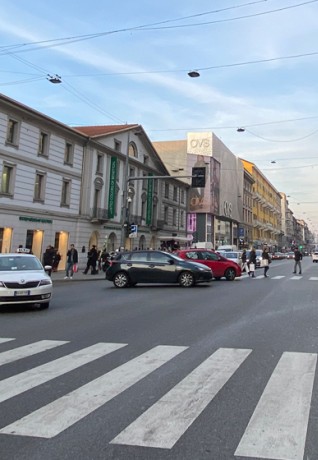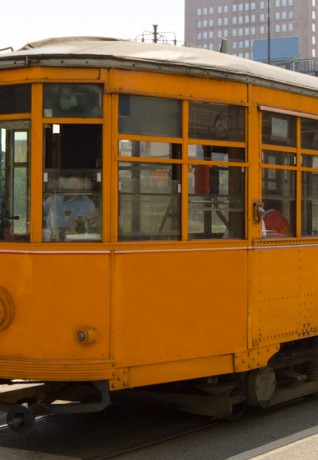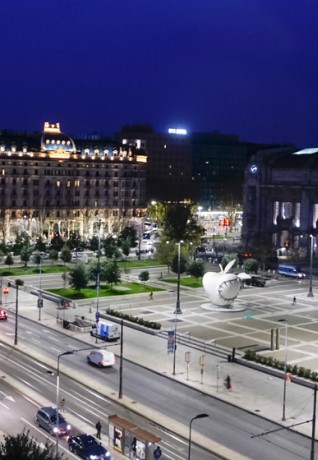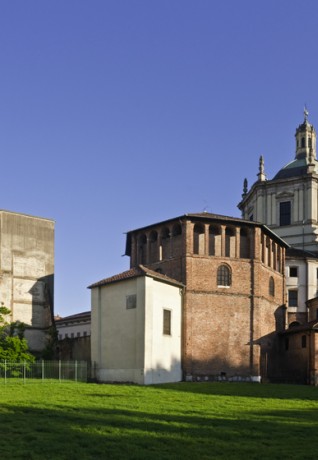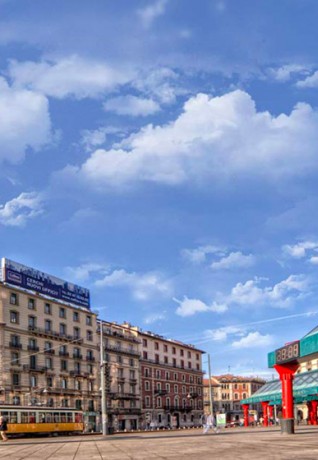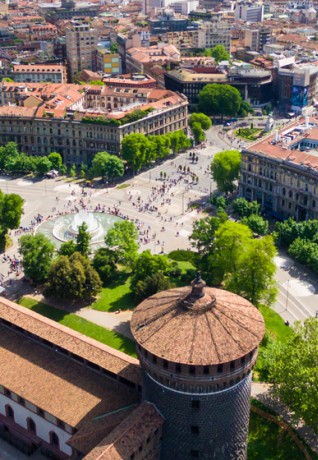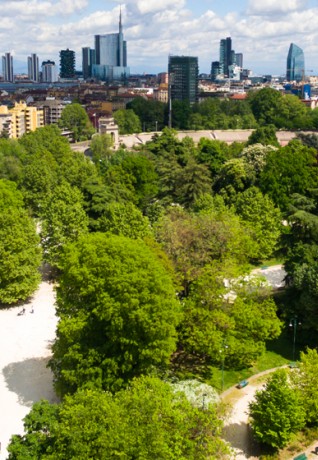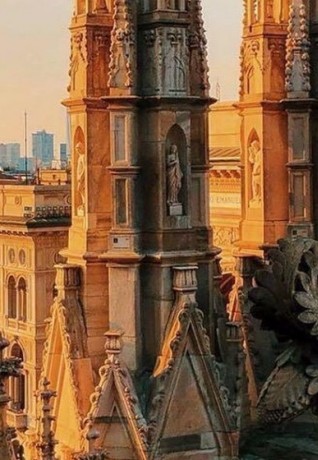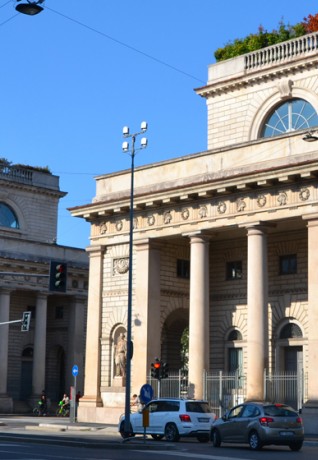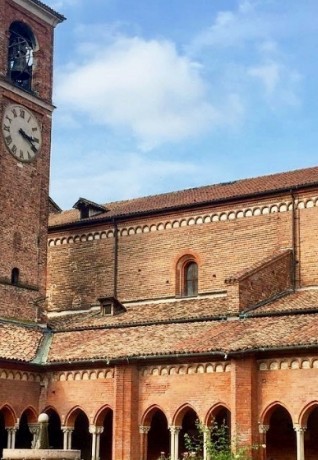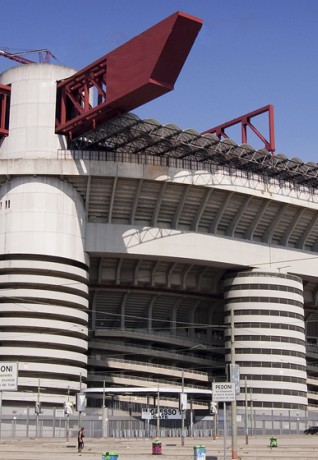Accessible itinerary: the city of the future
From Piazza Gae Aulenti to the Brera district
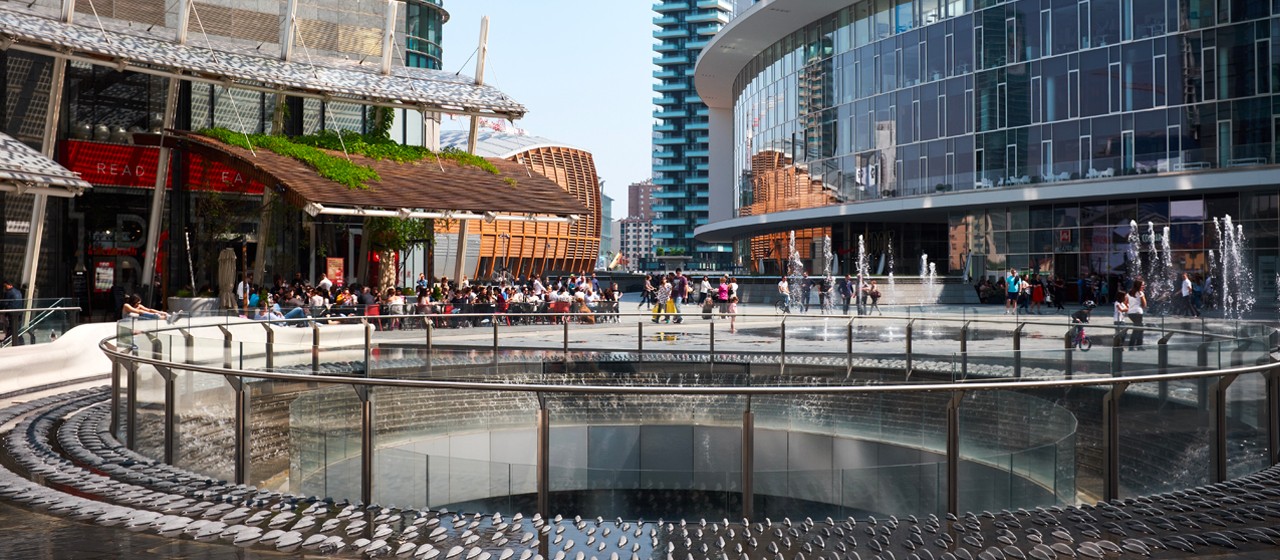
The starting point of this itinerary is Piazza Gae Aulenti.
How to get there
Piazza Gae Aulenti can be reached by the M2 and M5 undergrounds (Garibaldi FS stop), or by trams 10 and 33.
For more information for passengers with disabilities, please visit the ATM web page.
It is also possible to use the trains of the Passante Ferroviario (Garibaldi FS stop).
More information for passengers with disabilities can be found by visiting the Trenord website.
In Piazza Freud, in front of the Garibaldi railway station, there are two parking places reserved for disabled pass holders and a pay parking of about 50 spaces.
From Piazza Freud, after a 50 m walk along a pedestrian street (average gradient: 5%), cross viale Luigi Sturzo. Piazza Gae Aulenti can be reached by means of a wide glass lift (with an acoustic warning of arrival at the floor) or alternatively by using an escalator.
Just outside the elevator, there is a plaque with a tourist description of the square (in Italian and Braille) and with a relief map of the area. QR Code and NFC, that can be activated with a smartphone, allow you to consult an audio-video description, with subtitles and translation into LIS (Italian Sign Language).
Designed by the Argentine architect Cesar Pelli and inaugurated on December 8, 2012, Piazza Gae Aulenti is surrounded by three buildings, among which the UniCredit Tower which is one of the tallest skyscrapers in Italy (231 meters). From the tower, you can admire a panoramic view of the Milanese skyline: the new building of the Lombard Regional Council, the Diamante Tower and the Pirelli Skyscraper (also called "Pirellone") designed by Gio Ponti.
From Piazza Gae Aulenti take the lift or escalators and go down to level minus one, turn left and cross via Fratelli Castiglioni (crossing with uneven ground and tram rails). After walking through the "Anna Politkovskaja" gardens, cross via De Cristoforis (paved crossing in good condition) and take Corso Como (about 200 m long, this is a pedestrian area, with cobblestones slightly disconnected in the centre and paved paths in good conditions to the sides).
Corso Como is full of restaurants, pizzerias, lounge bars and discos. At 10, Corso Como, on the first floor of a former industrial building typical of the Milanese architecture of the late 1800s, there is the "Galleria Carla Sozzani", an exhibition space dedicated to photography, art, design and architecture.
At the end of Corso Como, you can see the gate of Porta Garibaldi which stands in the middle of Piazza XXV Aprile. It is one of the six main gates of Milano, built within the Bastioni, the walls that surrounded the city during the Spanish domination. The building on the left of the square, formerly the Teatro Smeraldo, is now occupied by Eataly, the temple of Italian food and wine of excellence.
Cross the square (first crossing with two paved paths, second crossing with a traffic light and uneven paving) and reach Corso Garibaldi (a limited traffic area, paving in cobblestones with paved path), a street with little traffic, full of shops and interesting monuments to visit, including the church of Santa Maria dell'Incoronata, a peculiar example of "double church" (parvis in cobblestones with paved paths).
Cross via Marsala (inclined ramp with threshold) and walk the last two hundred meters of Corso Garibaldi (cobblestones with a paved path) until you reach Largo La Foppa, where you can stop for a coffee or a glass of wine.
To continue your itinerary, keep on the left side of Largo La Foppa and cross via della Moscova and then via Statuto. From here you can continue your walk along the most suggestive stretch of Corso Garibaldi. After about 500 meters, on the left, there is the square and the church of San Simpliciano (cobblestones with paved path).
Do not miss a visit to the Brera district.
At the end of Corso Garibaldi, cross the road and turn left onto Via Pontaccio (narrow sidewalk with bumpy stretches). At the corner with Vicolo Fiori, there is a crossing with a threshold. By walking for about 200 meters you reach the square and church of San Marco. The road crossings to get to the church are in uneven paving.
If you go back to via Pontaccio, you reach the Senesi garden and take the alley Piero Manzoni on the left, after a few meters turn left and you will be in via Brera (cobblestones at times uneven).
After an 80 m walk, you reach the Pinacoteca di Brera. The museum is in Palazzo di Brera, built on an ancient fourteenth-century convent of the order of the Umiliati where you can also find the Braidense Library, the Botanical Garden, the Astronomical Observatory and the Academy of Fine Arts.
The Pinacoteca was opened to the public in 1810 and today it includes masterpieces by important Italian artists (from the 14th to the 19th century) such as Piero della Francesca, Mantegna, Raffaello, Bramante, Caravaggio and Tintoretto.
Leaving the Pinacoteca, the itinerary continues in the Brera district, with its characteristic pedestrian streets that are typical of the old Milan. The area has been the destination for artists since the 19th century and is today famous for its antique shops, small shops and trendy clubs.
Take via Fiori Chiari (cobblestones with narrow paved paths) and turn left in via Madonnina (cobblestones with narrow paved paths), then you arrive at the church of Santa Maria del Carmine, located in the homonymous square which opens onto via Ponte Vetero.
With your back to the church of Santa Maria del Carmine, take Via Cusani on your left and after 100 meters, at the traffic light, cross the street (crossing with tram rails and uneven paving). Once on the opposite sidewalk, going back for about 50 meters you reach a tram stop where you can take tram: 2, 12 and 14 (tram 14 is accessible to wheelchair users). From here, in two stops, you arrive in Piazza Duomo, where you can take the M1 and M3 underground lines, both equipped with a lift.

 Log in
Log in


